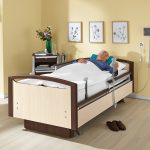Not only do care-dependent people, who have to stay in bed, rely on an ergonomically high-quality and comfortable bed, the professional nursing staff also benefit from well-thought out beds that enable a reduction in back strain from nursing care and save time.
Even healthy people spend around a third of their lives in bed, but ill people spend much more time in bed. This is reason enough for a comfortable bed that not only ensures optimal positioning, relief and recovery while sleeping, but also during the day. A nursing home bed therefore needs to be adapted to suit the specific requirements of people who need care as well as to the working conditions of the nursing staff.
All about the bed
In today’s world, in which modern low nursing beds have already become established, it is hard to imagine the simple wooden beds were only replaced by more comfortable, adjustable beds around the turn of the century 1800/1900, which were increasingly able to be adjusted to the individual and more stringent hygiene requirements and were equipped with hydraulics over the course of time. Now, modern hospital and nursing home beds are subject to specific standards and regulations and meet high medical, hygienic and nursing requirements. They have functions such as controllable segments of the slatted frame, tilting and rotating functions, height adjustment to prevent falls and to ensure safety, mobilization and standing-up aids that generally facilitate bedding measures and the work of professional nursing staff and have a positive influence on the quality of life of care-dependent people.
For instance, a new generation of low nursing beds (sentida 5/6) with a 3-stop strategy not only offers safe fall prevention while sleeping, but also an optimum mobilization and nursing position, without putting strain on the back. This allows the bed height to be adjusted from 27 cm floor height (for sleeping) with an automatic stop at chair height of 41 cm for mobilization, to 80 cm for nursing tasks. The nursing staff can also set the bed to pre-programmed bed positions for comfort seating and bedsore prevention quickly and simply using a handset. The ergonomic BiNetik patient surface thus optimizes bedsore prevention. With double retraction, the patient surface can be extended by up to 17 cm and the additional 6 cm leg rest retraction is far superior to single backrest retraction. The BiNetic system noticeably reduces pressure in the lumbar and pelvic area.


